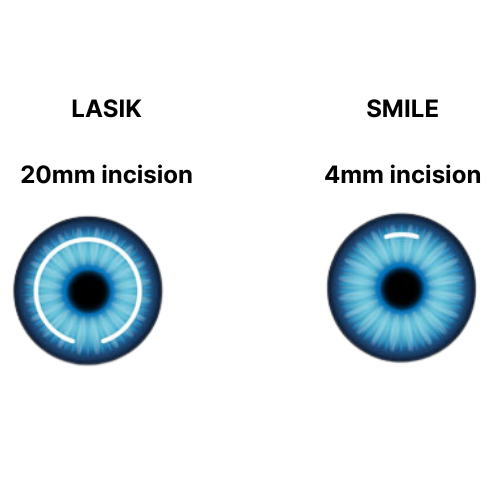Updated on April 7, 2025
What Is ReLEx SMILE Surgery?


Vision Center is funded by our readers. We may earn commissions if you purchase something via one of our links.
Summary
- ReLEx SMILE is a newer alternative to existing refractive eye surgeries like LASIK.
- The outcomes are comparable to traditional surgical methods and have lower risks of complications such as dry eye.7
- All procedures have benefits and risks, and some people may not be a good candidate for all surgeries.
- Talk with your ophthalmologist to determine which option is best for you.
What is ReLEx SMILE Eye Surgery?
ReLEx SMILE eye surgery is a type of refractive surgery that corrects vision issues. It’s a relatively new refractive eye surgery. Doctors first performed it in 20081.
ReLEx SMILE stands for:
- ReLEx. Refractive lenticule extraction
- SMILE. Small incision lenticule extraction

SMILE surgery uses a femtosecond laser, or a high-speed, short-pulsed laser, to remove a cornea section. The shape changes when part of the cornea is removed and refractive errors are corrected.
The U.S. Food and Drug Administration (FDA) approved the use of the VisuMax Femtosecond Laser in 2016 for the SMILE procedure.2
Listen In Q&A Format
What Is ReLEx SMILE Surgery?
Vision Center Podcast
What Refractive Errors Can SMILE Correct?
SMILE is approved to correct myopia and astigmatism.
In the U.S., SMILE procedures have been approved to treat myopia (short-sightedness) since 2016. This occurs when people can see things close up but can’t see things clearly from a distance.
Myopia can occur when the eye focuses light directly in front of the retina. It is often due to a too-long eyeball, a too-steep cornea, or a combination of the two.
Since 2018, however, the FDA has approved SMILE for treating astigmatism and myopia.3 Astigmatism is when an irregularly shaped cornea causes blurry vision.
ReLEx SMILE Success Rate
One study observed people who had SMILE surgery 3 years prior. It showed that vision was better than or equal to 20/20 in 90% of participants.6 Different studies suggest a range of 65 to 100% efficacy for SMILE.
The ReLEx SMILE procedure has not been around as long as other vision correction surgeries. The long-term success rate is still under investigation.
Benefits of SMILE ReLEx Surgery
One of the main reasons why people choose SMILE as their refractive surgery is their benefits. Some of the main benefits of this laser eye surgery include:
- Minimally invasive. Less likely to cause complications and better for people who are not comfortable with a more invasive procedure
- Flap-Free. Unlike LASIK, does not require the creation of a corneal flap; lower risk of corneal flap-related complications
- Reduced dry eye symptoms. Since fewer corneal nerves are transected during the treatment
- Better corneal stability. The flap made during SMILE is smaller than LASIK, leading to better corneal stability in the long run; ideal for those with thinner corneas or people at risk of developing keratoconus
SMILE Procedure: What to Expect
Before undergoing laser eye surgery, your ophthalmologist will talk through expectations. This ensures they are realistic and you’re not disappointed with the results.
Some people might still have to wear glasses or contact lenses for certain activities after laser eye surgery. But most people can carry out most of their day-to-day tasks without them.
Preparing for Surgery
After discussing and managing expectations, your ophthalmologist will conduct an eye exam to ensure you are suitable for the procedure. This will include:
- Conducting an eye test. The ophthalmologist will test your nearsightedness level to ensure SMILE will correct it. They will also look for other refractive errors that could impact surgery or that SMILE could worsen.
- Cornea mapping. To program the computer-based laser, your ophthalmologist will take several measurements, including the thickness and surface mapping of the cornea.
- Measuring your pupil size. Finally, your ophthalmologist will measure the size of your pupil.
Before and During Surgery
Before this refractive surgery, your doctor will administer numbing eye drops. They will use a speculum to prevent you from blinking.
Procedure
The procedure consists of three main steps:
- A femtosecond laser will create a thin layer, the shape of a contact lens, inside the intact cornea. This is called a lenticule.
- It will also make a small incision (approximately 4mm long) in the cornea.
- The ophthalmologist will remove the lenticule through the incision.
SMILE laser eye surgery usually takes around 10 to 15 minutes per eye. Ophthalmologists typically only use the laser for about 30 seconds.4
After Surgery (Recovery)
Most people will have a hazy vision right after the procedure. Driving the day after the procedure is typically safe, but this depends on the person.
It is important to avoid certain things that may irritate your eyes, such as:
- Television
- Cell phones
- Tablets
- Computer screens
Avoid these devices for around 2 to 3 days after your refractive surgery.
Ideal Candidates for ReLEx SMILE Surgery
ReLEx SMILE surgery is a great option for those looking to improve their visual acuity. You’re an ideal candidate for ReLEx SMILE surgery if you:
- Are 21 years or older
- Have had a stable glass prescription for the last two years. Those with unstable prescriptions may not reach their desired results since the correction may not be accurate
- Want to correct myopia or astigmatism
On the other hand, you aren’t a good candidate for this treatment if you:
- Are suffering from an eye disorder like cataracts, glaucoma, or keratoconus
- Have a disease that slows down healing time
- Are currently pregnant or breastfeeding (best to wait afterward before receiving the treatment)
Always consult your eye doctor before undergoing any refractive surgery. There may be cases where your doctor needs to treat another condition before proceeding with SMILE.
Post-Operative Care for ReLEx SMILE
Post-operative care for ReLEx SMILE is similar to other eye treatments. Proper aftercare is essential to prevent any complications.
To take care of your eyes after this vision correction surgery, you must do the following:
- Rest your eyes. Avoid anything that can strain your eyes, such as prolonged screen time and strenuous activities
- Use prescribed eye drops. Your surgeon may prescribe antibiotic eye drops; use them as directed to ensure proper healing
- Avoid rubbing your eyes. Rubbing or touching your eyes can irritate your eyes after the surgery
- Avoid makeup and creams. Don’t put makeup around your eye area for at least 15 days to prevent possible infections
- Attend follow-up appointments. Always attend your follow-up appointments so that your doctor can monitor your progress
Side Effects and Risks of ReLEx SMILE
As with all surgeries, the ReLEx SMILE procedure has side effects and risks, although research suggests they are minimal.5
Some of the most common side effects include:
- Inflammation around the treated area
- Glare and halos around lights, particularly at night
- Debris where the corneal disc was removed
- Infection
One frequent side effect of most refractive eye surgeries is dry eye. Research suggests a nonsignificant reduction in postoperative tear production for people who undergo SMILE.
This means that the risk of developing dry eye with SMILE is minimal compared to other procedures, such as LASIK.5
How Much Does ReLEx SMILE Cost?
The cost of ReLEx SMILE surgery is around $2,000 to $3,000.8 This cost is similar to LASIK surgery.
Insurance coverage may vary for this procedure, though. Most insurance providers won’t cover the costs of the procedure.
However, it’s best to ask your insurance provider or surgeon whether they’ll cover the costs of SMILE surgery.
ReLEx Smile vs. LASIK
An alternative to SMILE is LASIK (laser-assisted in situ keratomileusis). Both treatments have the same goals, but they also have their differences.

Similarities
SMILE and LASIK are similar in many ways:
- Risk. Both procedures have minimal risk
- Downtime. Both procedures allow people to resume daily activities within a few days post-surgery
- Cost. Generally, the price of LASIK and SMILE are comparable
- Recovery time. Most people have 20/20 vision within a couple of days, regardless of whether they have SMILE or LASIK
- Quick. Both procedures take 10 to 15 minutes per eye and require no inpatient stay
Differences
While SMILE and LASIK surgery have many similarities, there are reasons someone may choose one procedure over the other.
Major differences include:
| ReLex SMILE | LASIK |
| Is only approved in the United States for correcting myopia (nearsightedness) and astigmatism | Can correct many refractive errors, including myopia (nearsightedness), astigmatism, and hyperopia (farsightedness) |
| Uses a femtosecond laser | Uses both an excimer and femtosecond laser |
| Does not require a corneal flap but instead makes an incision that is typically less than 4mm long | Creates a flap in the cornea before reshaping it to correct refractive errors |
| Fewer postoperative restrictions; for example, people can play outdoor sports without worrying about the flap | Requires postoperative restrictions to ensure the flap does not dislodge |
| People can return to outdoor activities and swimming within the first week after the procedure | Surgeons may advise people to wait between 15 days to a month to resume outdoor activities and swimming |
Because SMILE is relatively new, most surgeons recommend LASIK instead. Further research is necessary to understand the long-term outcomes of SMILE.
In this article
8 sources cited
Updated on April 7, 2025
Updated on April 7, 2025
About Our Contributors
based information about eye care. Our team, comprising doctors, researchers, and writers, is dedicated to our mission of delivering accurate and reliable visual health content, constantly creating, publishing, and updating to ensure the highest quality of information.
Dr. Melody Huang is an optometrist and freelance health writer with a passion for educating people about eye health. With her unique blend of clinical expertise and writing skills, Dr. Huang seeks to guide individuals towards healthier and happier lives. Her interests extend to Eastern medicine and integrative healthcare approaches. Outside of work, she enjoys exploring new skincare products, experimenting with food recipes, and spending time with her adopted cats.

